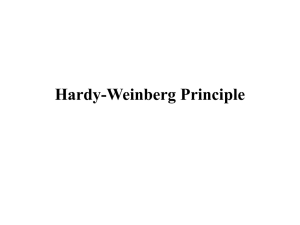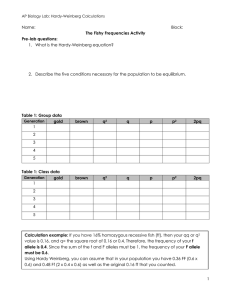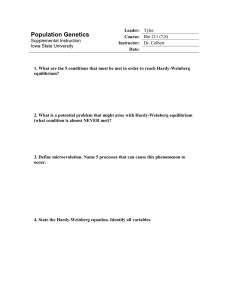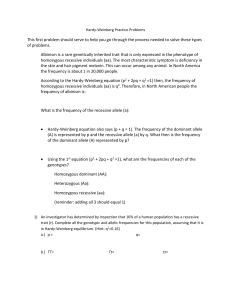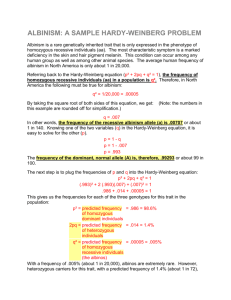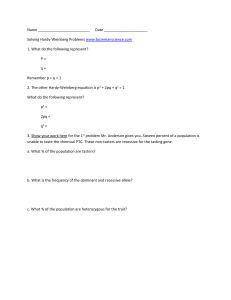Population Genetics and Hardy-Weinberg Genetic Equilibrium Name: Evolution
advertisement
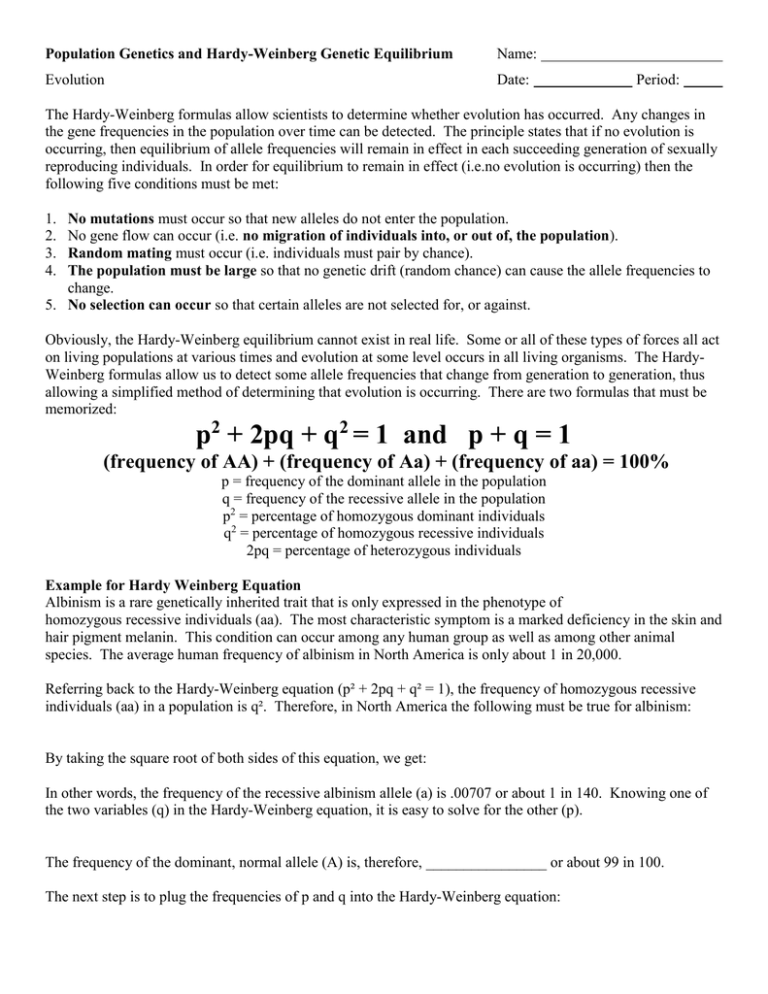
Population Genetics and Hardy-Weinberg Genetic Equilibrium Name: Evolution Date: Period: The Hardy-Weinberg formulas allow scientists to determine whether evolution has occurred. Any changes in the gene frequencies in the population over time can be detected. The principle states that if no evolution is occurring, then equilibrium of allele frequencies will remain in effect in each succeeding generation of sexually reproducing individuals. In order for equilibrium to remain in effect (i.e.no evolution is occurring) then the following five conditions must be met: 1. 2. 3. 4. No mutations must occur so that new alleles do not enter the population. No gene flow can occur (i.e. no migration of individuals into, or out of, the population). Random mating must occur (i.e. individuals must pair by chance). The population must be large so that no genetic drift (random chance) can cause the allele frequencies to change. 5. No selection can occur so that certain alleles are not selected for, or against. Obviously, the Hardy-Weinberg equilibrium cannot exist in real life. Some or all of these types of forces all act on living populations at various times and evolution at some level occurs in all living organisms. The HardyWeinberg formulas allow us to detect some allele frequencies that change from generation to generation, thus allowing a simplified method of determining that evolution is occurring. There are two formulas that must be memorized: p2 + 2pq + q2 = 1 and p + q = 1 (frequency of AA) + (frequency of Aa) + (frequency of aa) = 100% p = frequency of the dominant allele in the population q = frequency of the recessive allele in the population p2 = percentage of homozygous dominant individuals q2 = percentage of homozygous recessive individuals 2pq = percentage of heterozygous individuals Example for Hardy Weinberg Equation Albinism is a rare genetically inherited trait that is only expressed in the phenotype of homozygous recessive individuals (aa). The most characteristic symptom is a marked deficiency in the skin and hair pigment melanin. This condition can occur among any human group as well as among other animal species. The average human frequency of albinism in North America is only about 1 in 20,000. Referring back to the Hardy-Weinberg equation (p² + 2pq + q² = 1), the frequency of homozygous recessive individuals (aa) in a population is q². Therefore, in North America the following must be true for albinism: By taking the square root of both sides of this equation, we get: In other words, the frequency of the recessive albinism allele (a) is .00707 or about 1 in 140. Knowing one of the two variables (q) in the Hardy-Weinberg equation, it is easy to solve for the other (p). The frequency of the dominant, normal allele (A) is, therefore, ________________ or about 99 in 100. The next step is to plug the frequencies of p and q into the Hardy-Weinberg equation: This gives us the frequencies for each of the three genotypes for this trait in the population: p² = predicted frequency of homozygous dominant individuals 2pq = predicted frequency of heterozygous individuals q² = predicted frequency of homozygous recessive individuals (albinos) With a frequency of ____________ (about 1 in 20,000), albinos are extremely rare. However, heterozygous carriers for this trait, with a predicted frequency of ____________ (about 1 in 72), are far more common than most people imagine. There are roughly 278 times more carriers than albinos. Clearly, though, the vast majority of humans ____________ probably are homozygous dominant and do not have the albinism allele. PROBLEM #1 - View the Dragons on the right. The winged trait is dominant. Frequency 2 q (aa) = q (a) = p (A) = p2 (AA) = 2pq (Aa) = What is the frequency (%) of the heterozygote dragons in the population. PROBLEM #2 You have sampled a population in which you know that the percentage of the homozygous recessive genotype (aa) is 36%. Using that 36%, calculate the following: A) The frequency of the "aa" genotype. B) The frequency of the "a" allele. C) The frequency of the "A" allele. D) The frequencies of the genotypes "AA" and "Aa." E) The frequencies of the two possible phenotypes if "A" is completely dominant over "a." PROBLEM #3 Within a population of butterflies, the color brown (B) is dominant over the color white (b). And, 40% of all butterflies are white. Given this simple information, calculate the following: A) The percentage of butterflies in the population that is heterozygous. B) The frequency of homozygous dominant individuals. PROBLEM #4 The ability to taste PTC is due to a single dominate allele "T". You sampled 215 individuals in biology, and determined that 150 could detect the bitter taste of PTC and 65 could not. Calculate all of the potential frequencies.



